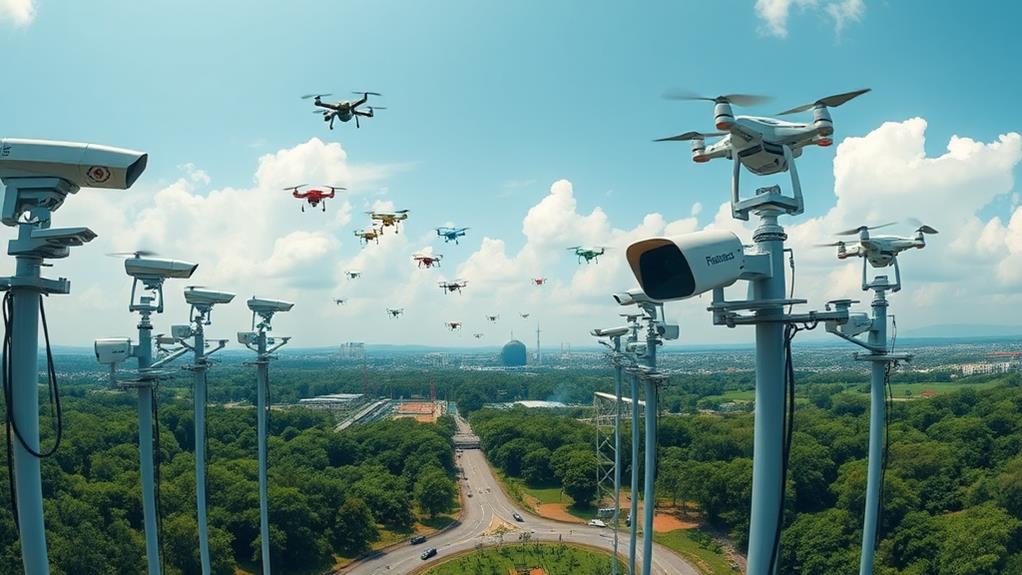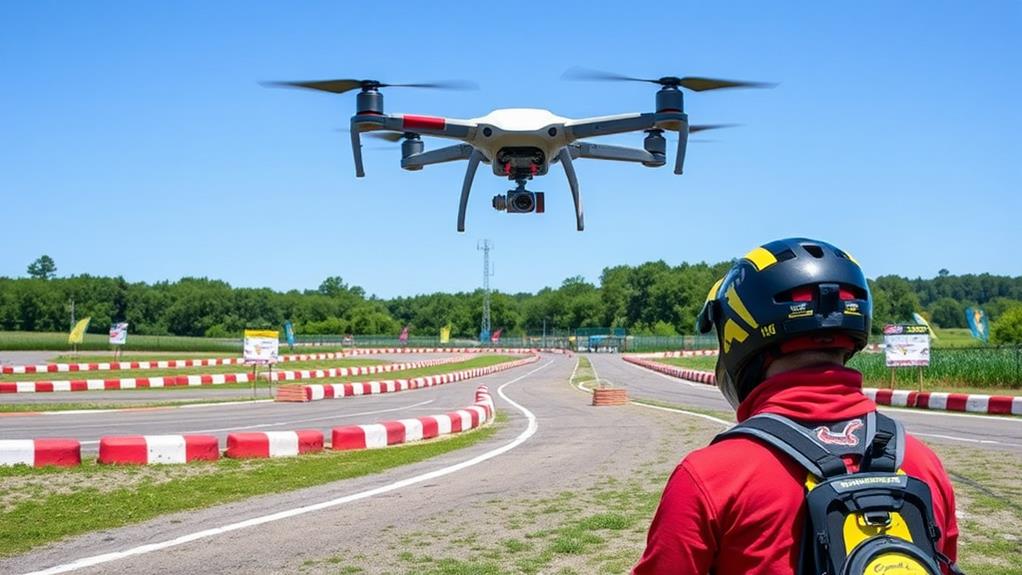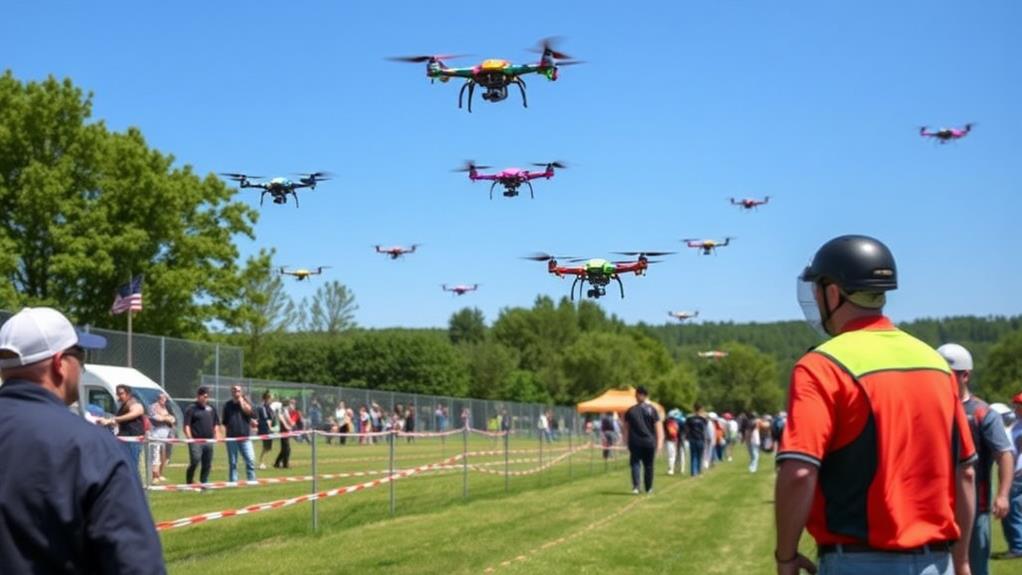To guarantee safety at drone sports events, focus on five essential measures. First, use access control protocols like designated entry points and identification systems to screen attendees effectively. Second, conduct emergency preparedness drills involving local law enforcement for quick responses. Third, implement real-time surveillance systems to monitor crowds and detect drones. Fourth, manage crowd dynamics by designating spectator areas and training staff in crowd control. Finally, promote participant education programs emphasizing safe drone operations and awareness of airspace regulations. These strategies create a safer environment, so consider how each plays a crucial role in event security. You'll discover even more insights soon.
Access Control Protocols

When organizing drone sports events, implementing effective access control protocols is essential for ensuring safety. You'll want to establish designated entry points where attendees are screened for unauthorized drones. This approach helps prevent potential incidents and maintains a secure environment.
Using a robust identification system, like wristbands or QR codes, can further enhance security by ensuring only ticketed individuals gain access to the venue. Additionally, it's important to understand local regulations that govern drone operations, as compliance can notably improve safety measures in place.
Employing technology, such as drone detection systems at these entry points, plays a critical role in monitoring for unauthorized drones. These systems can intercept any unauthorized drone before it enters the event area, providing an added layer of safety.
It's also essential to invest in regular training for your security personnel. By keeping them updated on drone detection and response procedures, you reinforce effective access control management.
Establishing clear communication channels with law enforcement and event staff at access points is another key strategy. This allows for swift responses to any detected drone threats, ensuring that safety remains a top priority throughout the event.
Emergency Preparedness Drills
Implementing access control protocols sets the foundation for safety, but it's equally important to prepare for emergencies that may arise during drone sports events.
Emergency preparedness drills should focus on specific scenarios related to drone incursions. These drills help your security personnel respond effectively to potential threats. By regularly conducting training exercises, you clarify roles and responsibilities among your team, guaranteeing seamless coordination during incidents involving drones.
Incorporating real-time data from drone detection systems into these drills enhances situational awareness and improves response times. Engaging local law enforcement in emergency drills fosters collaboration and guarantees that everyone understands their roles in managing drone threats. This teamwork is essential, as it can greatly impact how quickly and effectively an incident is resolved.
Additionally, evaluating the effectiveness of your drills through feedback and performance assessments allows for continuous improvement in your emergency response protocols related to UAV incidents.
Real-Time Surveillance Systems

Real-time surveillance systems play an important role in ensuring the safety of drone sports events. These advanced systems utilize real-time video analytics to monitor crowds and spot suspicious behavior, greatly enhancing security measures.
By integrating with existing CCTV networks, they provide extensive coverage of the event venue, allowing for rapid incident response when needed.
One of the standout features of these surveillance technologies is their ability to detect unauthorized drones. They continuously monitor airspace, alerting security personnel to potential threats in real-time. This capability is vital as it helps prevent accidents or disruptions caused by rogue drones flying into the event area.
Enhanced features like thermal imaging and facial recognition assist security teams in managing access control. They help identify individuals around drone operations, ensuring that only authorized personnel are present.
The presence of real-time surveillance systems not only improves situational awareness but also acts as a deterrent against potential drone-related incidents.
Effective Crowd Management
Effective crowd management is essential for ensuring safety at drone sports events. By implementing strategic measures, you can markedly reduce potential security threats while enhancing the experience for all attendees.
Clear communication protocols are vital; they keep spectators informed about safety measures and emergency procedures, which boosts overall awareness.
Here are some effective strategies for crowd control:
- Designated Areas: Create specific zones for spectators and restrict access to drone flight areas to prevent unauthorized entry.
- Controlled Entry and Exit: Manage entry and exit points to minimize panic during a drone-related incident, allowing for a swift response.
- Staff Training: Train event staff on crowd management techniques to handle potential drone incursions effectively.
- Regular Drills: Conduct simulations of potential drone incidents to prepare security teams and event personnel, fostering a culture of vigilance.
- Real-Time Communication: Establish a system for real-time updates, ensuring attendees receive immediate notifications about any security threats.
Participant Education Programs

To guarantee a safe and enjoyable experience at drone sports events, participant education programs play an indispensable role. With over 1 million drones registered in the U.S. as of January 2023, understanding safe drone operation practices is significant. Since pilot error is the leading cause of incidents, thorough training is essential.
Incorporating hands-on workshops into these education programs enhances your understanding of drone technology and regulations. This knowledge helps prevent unauthorized flights and potential safety breaches during events.
It's also important to learn about airspace restrictions and the legal implications of operating drones near venues with specific UAV policies.
Regularly scheduled briefings before events keep you informed about the latest safety measures and incident reporting protocols related to drone activities. Engaging in discussions about the potential risks associated with drones, such as weaponized payloads and surveillance, fosters a culture of safety and vigilance.
Conclusion
To sum up, ensuring safety at drone sports events is like building a strong fortress. By implementing access control protocols, conducting emergency preparedness drills, utilizing real-time surveillance, managing crowds effectively, and educating participants, you create a secure environment for everyone involved. Each measure acts as a sturdy brick, fortifying the event against potential risks. As drone sports continue to grow, prioritizing safety will help maintain excitement while protecting participants and spectators alike. Stay informed and ready to fly safely!

Leave a Reply